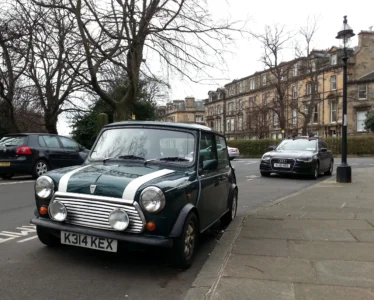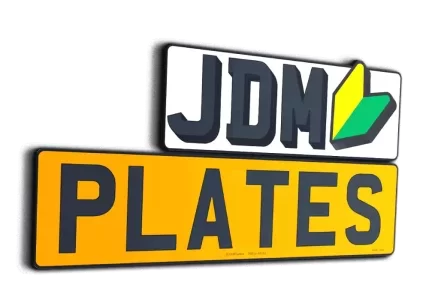How to Read Prefix & Suffix Number Plates
Understanding how to read prefix and suffix number plates gives you a valuable glimpse into a vehicle’s age and history. Whether you’re exploring private registration options or just curious about your car’s background, this guide from JDM Plates makes it easy to decode these classic UK number plate formats.
What Are Prefix and Suffix Number Plates?
Prefix and suffix number plates were used in the UK before the current registration system came into effect in 2001. These older styles are most commonly seen on vintage vehicles, collectors’ cars, or private registrations designed to imitate classic formats.
- Suffix number plates were used from 1963 to 1983
- Prefix number plates were followed from 1983 to 2001
Suffix registrations were introduced when the dateless system ended, with the letter at the end showing the year. Prefix registrations replaced them in 1983, moving the year indicator to the beginning.
Both styles are still legal and widely used on private number plates for stylistic or sentimental reasons.
How Do Suffix Number Plates Work?
A suffix number plate ends with a letter that identifies the vehicle’s year of registration.
Format: ABC 123A
- The first three letters are random and often include a regional identifier
- The three numbers range from 1 to 999
- The final letter (suffix) shows the year of registration
Example: XYZ 456J
The suffix “J” means the vehicle was registered between 1 August 1970 and 31 July 1971.
Suffix Year Reference
| Suffix | Year Issued |
| A | 1963 to 1964 |
| E | 1967 to 1968 |
| H | 1969 to 1970 |
| J | 1970 to 1971 |
| N | 1974 to 1975 |
| Y | 1982 to 1983 |
Letters such as I, O, Q, and Z were not used to avoid confusion or because they were reserved.
Where Will You See Suffix Plates?
- Classic British vehicles like Minis, Triumphs, and Fords
- Restored vintage cars using era-accurate registrations
- Private plates replicating historic number plate styles
Can You Use a Suffix Plate Today?
Yes, but only on a vehicle that is the same age or newer than the suffix year. You cannot use a suffix plate on an older car to make it appear newer.

How Do Prefix Number Plates Work?
A prefix number plate starts with a letter that shows the year the vehicle was registered.
Format: A123 XYZ
- The first letter (prefix) reveals the year of registration
- The three numbers range from 1 to 999
- The final three letters are random and can include area identifiers
Example: K456 ABC
The prefix “K” means the car was registered between 1 August 1992 and 31 July 1993.
Prefix Year Reference
| Prefix | Year Issued |
| A | 1983 to 1984 |
| D | 1986 to 1987 |
| F | 1988 to 1989 |
| H | 1990 to 1991 |
| M | 1994 to 1995 |
| Y | 2000 to 2001 |
Letters like I, O, Q, U and Z were not used for clarity or regulatory reasons.
Where Will You See Prefix Plates?
- Vehicles from the 1980s, 1990s, and early 2000s
- Used cars that have retained their original registrations
- Custom private plates are designed in a classic style
Can You Use a Prefix Plate on Any Car?
Only if the car is the same age or newer than the prefix date, you cannot use a prefix to make a car seem newer.
What Do Regional Identifiers and Area Codes Mean?
Regional identifiers, also known as area codes, appear on UK number plates to show where the vehicle was first registered.
In suffix plates, the first one to three letters often include the area code.
In prefix plates, the last three letters serve this function.
Examples:
- ABC 123A – “ABC” is the regional identifier
- A123 XYZ – “XYZ” shows the registration location
Some examples of regional identifiers:
- GG – Glasgow
- GH, GP – London
- HY – Bristol
- LA to LT, LC, LU, LY – London codes
- GX, GJ, GU – Additional regional London identifiers
Understanding these codes allows you to trace a vehicle’s origin. For collectors or buyers, this can add historical interest or even value.
What’s the Difference Between Prefix and Suffix Number Plates?
| Feature | Suffix Number Plates | Prefix Number Plates |
| Year Indicator | At the end of the plate | At the beginning of the plate |
| Format Example | XYZ 456A | A123 XYZ |
| Used From | 1963 | 1983 |
| Used Until | 1983 | 2001 |
| Updated Each Year | August | August |
Why Does Reading Number Plates Still Matter?
Even though these styles are no longer in use for new registrations, understanding how to read a prefix number plate or suffix number plate is still important:
- To confirm the age of a classic or vintage car
- To choose a private plate that matches a birth year or a significant date
- To ensure DVLA compliance when assigning age-related plates
- To verify the legitimacy of custom or stylised registrations
Looking to read UK number plates? Read our online guide at JDM Plates.
Ready for a Classic-Inspired Number Plate?
At JDM Plates, we offer custom legal number plates designed to match vintage formats, including both prefix and suffix styles. Whether you’re restoring a classic or want a plate that reflects a personal date, we’ve got the perfect option for you. Explore Prefix and Suffix Style Plates at JDM Plates.

